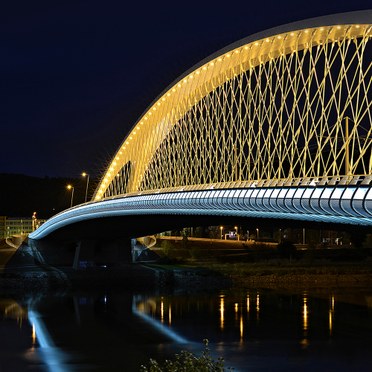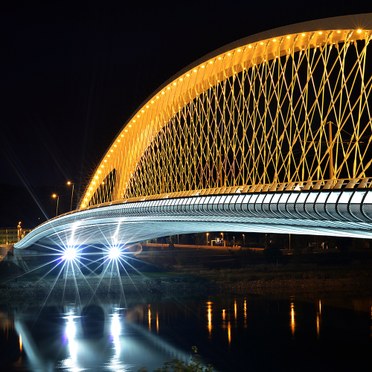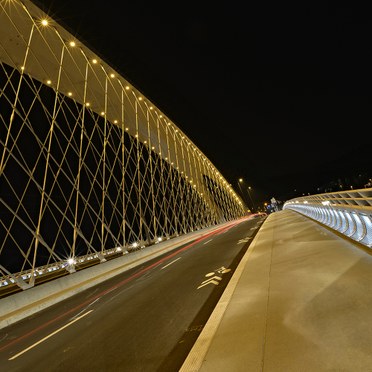Troja Bridge, Czech Republic
- Lamp efficacy
Lamp efficacy
Ensuring the lamp efficiently converts electricity into light (lm/W).
- Ballast classification
Ballast classification
Controlling the electricity supply to the lamp (Energy Efficiency Index).
- Luminaire distribution
Luminaire distribution
The specific light distribution of Orus minimises light loss within the volume of space between the luminaire and the road. This is especially valuable on bridges where wet weather conditions (rain, mist …) may attenuate the light dramatically with high mounted luminaires.
- System efficacy
System efficacy
Combining optical and thermal control within the luminaire (luminaire lm/W).
- Presence/absence detection
Presence/absence detection
Presence: Lights automatically turn on/off with movement. Absence: Lights automatically turn off and must be manually switched on.
- Daylight detection
Daylight detection
Artificial lighting which responds to the natural light conditions.
- Constant illuminance
Constant illuminance
A function designed to produce correct light levels for the duration of the maintenance period.
- Task-scene setting
Task-scene setting
Allowing the user to set scenes and adapt the lighting to different tasks.
- Timed off
Timed off
Automatic cut-off can be installed to turn all lights off during unoccupied hours.
- Task lighting
Task lighting
Each luminaire within the scheme has a specific task and task area. This maximises its efficiency by not spreading the light over too many tasks and areas which would result in over lighting and waste light.
- Zoning of lighting
Zoning of lighting
Lighting is zoned according to area use.
- Maintenance schedule
Maintenance schedule
Maintenance must be performed in response to product age, performance and environment.
- Waste light
Waste light
The positioning of the E/fact luminaires in the arches with tight beam control and low mounted Orus’ maximises useful light by minimising the amount of spill light. The lack of spill light can be seen by the darkness of the river on either side of the bridge.
- Reflectance
Reflectance
Taking advantage of light which is reflected from the surface within the space.
- Visible smart metering
Visible smart metering
Results of actions can be quickly seen as increased or decreased energy use to encourage responsible energy consumption.
The newly opened Troja Bridge is set to become a big attraction in Prague, Czech Republic. It impresses tourists and residents alike as the only bridge over the Vltava River without pillars. Its unique bowstring-arch structure is 200m long incorporating a double tram track and four traffic lanes for vehicles, pedestrians and cyclists. The bridge is stunning during the day but comes alive at night when the effect of the carefully designed illumination can be fully appreciated.
Lighting objectives
The designers from Studio Koutský Architekti understood at the project conception that the light and lighting of the bridge would play an important role in the overall look and effect of the construction. In search of the perfect lighting solution the architect Mr. Kábrt worked with Walter Jagsch, lighting designer at Thorn Lighting, to develop a lighting design to compliment this intricate structure of webbed wires.
Lighting solution
It was decided that dramatic effects would be created by simply using four colour temperatures within the lighting design, from the warmest white on the top of the arch to the coolest in the illumination of the lower areas of the bridge's structure. In the bridge's arches are E/Fact recessed floodlights (2000K) in ground mounted boxes. When combined with the illuminated bridge
hangers, they create an unforgettable image. With its low contact temperature and precision optics, E/Fact also illuminates the tram tracks. It was challenging to find a solution to house the products safely but still allow service access, but Thorn worked with the architects to find an easy solution.
Orus luminaires were chosen to illuminate the road and sidewalk. Using a 3000K colour temperature creates a visible contrast with the illumination of the arch. Orus' low mounting height of 0,9m is discreet and ensures the lighting integrates into the landscape without interfering with the structural design of the bridge.
Due to its unique Flat Beam® technology, Orus produces a precise light beam which provides a comfortable light for drivers and does not dazzle road users. At the same time, it illuminates the road lanes, the sidewalk and the bike path. For easy access, the Orus luminaires are placed in hinged boxes that safely conceal the wiring.
In the railings, E/Fact LED (5700K) is installed both for decorative lighting and to illuminate the sidewalks. The luminaires are positioned 1m apart, so that they can simultaneously illuminate the side cover and create a unique design with the characteristic outline of the bridge.
At the foot of the bridge on both sides Contrast R floodlights with antiglare optics have been installed. Their cool white light with a colour temperature of 5500K creates the coolest element of the lighting solution. The bridge deck is visually lightened from below so that an optical illusion of the bridge hovering above the river is created.
Results and benefits
The overall result is stunning and the impression is enhanced by reflections and mirroring in the Vltava River. The use of high precision optics and low energy luminaires ensures the sustainability of this beautiful lighting installation. Mr. Kábrt explains: “Already we see visitors trying to find the perfect angles to photograph this new landmark; the lighting brings this beautifully intricate structure alive.”
Key facts
• A mixture of colour temperatures ranging from 2000-5700K were used to create a dramatic lighting effected
• Products used include, Orus, E/Fact, E/Fact LED and Contrast R
• Troja Bridge is the only bridge over the Vltava River without pillars



